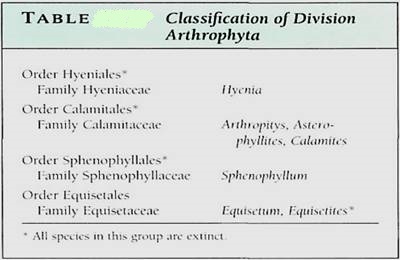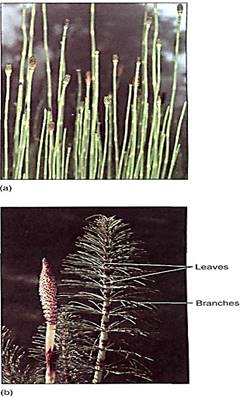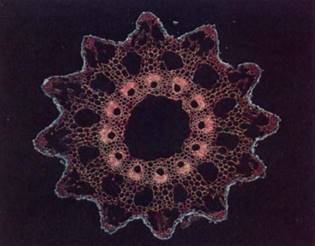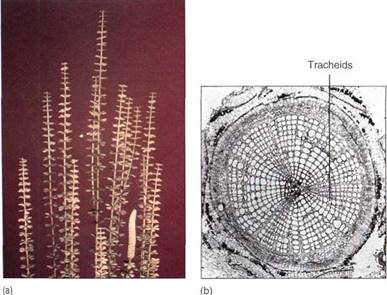


 النبات
النبات
 الحيوان
الحيوان
 الأحياء المجهرية
الأحياء المجهرية
 علم الأمراض
علم الأمراض
 التقانة الإحيائية
التقانة الإحيائية
 التقنية الحيوية المكروبية
التقنية الحيوية المكروبية
 التقنية الحياتية النانوية
التقنية الحياتية النانوية
 علم الأجنة
علم الأجنة
 الأحياء الجزيئي
الأحياء الجزيئي
 علم وظائف الأعضاء
علم وظائف الأعضاء
 الغدد
الغدد
 المضادات الحيوية
المضادات الحيوية|
Read More
Date: 15-11-2016
Date: 16-11-2016
Date: 16-11-2016
|
Division Arthrophyta
The division Arthrophyta (also called Sphenophyta) contains several genera of extinct plants and one genus, Equisetum, with 15 extant species known as horsetails or scouring rushes (Table 23.8). The living plants are all herbs without any secondary growth, and although certain species may attain a height of up to 10 m, they are usually less than 1 m tall (Fig. 1). Their aerial stems have a characteristic jointed structure, with a whorl of fused leaves at the nodes. The leaves are small and have just a single trace of vascular tissue, but they are small megaphylls, not microphylls. If branches are present, they alternate with the leaves rather than being located in the leaf axils. These are important pieces of evidence that arthrophytes are distinct from ferns and seed plants. The vertical, aerial stems arise from deep subterranean rhizomes; in harsh habitats, aerial shoots die during winter, but rhizomes persist and plants can spread vigorously. True roots are present, being produced at the rhizome's nodes. The evolutionary origin of roots is still uncertain.


FIGURE 1:Equisetum plants are small, having vertical shoots that arise from subterranean, highly branched rhizomes. In some species such as E. debile (a), each shoot is both photosynthetic and reproductive; in other species such as E. telmateia (b), two distinct types of shoots are produced. (a, R. and L Mitchell; b, W. E. Ferguson).
Internal structure is as distinctive as external morphology (Fig. 2). Stems have a pith, so these are siphonosteles, not protosteles as in all other plants mentioned so for (compare Fig. 2 ). Protoxylem forms next to the pith, interior to the metaxylem, so it is endarch, a rhyniophyte/trimerophyte trait distinctly different from the exarch protoxylem of zosterophyllophytes. Vessels are rare outside the flowering plants, occurring only in Selaginella, four ferns, three genera of gymnosperms, and Equisetum. Stem elongation causes some cells to be stretched and torn, forming canals. The cortex of Eusturn is composed of large cells, the outer ones chlorophyllous. Air canals maybe located in the outer cortex. The epidermis contains stomatal pores and guard cells, as well as such large amounts of silica that the stems are tough and rigid.

FIGURE 2:The stem anatomy of Equisetum is dominated by numerous canals. The center of the pith (this is a siphonostele) is torn apart, forming a central canal or pith canal, and around the remnants of the pith are carinal canals formed by the breakdown of protoxylem. Just exterior to the carinal canals are metaxylem and phloem; vascular bundles are endarch. No secondary growth occurs in any living Equisetum. The cortex contains cortical canals that alternate with the carinal canals, each cortical canal being located near a furrow in the stem surface. The adaptive value of these canals is not known, but this highly characteristic structure allows us to identify fossils related to Equisetum. (Jim Solliday/ Biological Photo Service).
Reproductive structures in Equisetum axe specialized; sporangia never occur singly, but always in groups of five to ten located on an umbrella-shaped sporangiophore (Fig 3). This has a short stalk and a flat, shield-shaped head from which the sporangia project, parallel to the sporangiophore stalk. The sporangiophores are always arranged in compact spirals forming a strobilus. Equisetum is homosporous, so all plants have only one type of sporangiophore and strobilus, but in some species, the strobilus occurs at the tip of a green photosynthetic shoot, whereas in others it is borne on a special, colorless reproductive shoot.
After spores are released, they germinate on moist soil and develop into small (1 mm across) green gametophytes. They have no vascular tissue at all and no epidermis or stomata; the body is just a small mass of parenchyma. Whereas the gametophytes of Psilotum are still somewhat complex, those of Equisetum, ferns, and seed plants are all mi and simple. The gametophytes of Equisetum are either male or bisexual. Antheridia release numerous multiflagellate sperms that swim to the archegonia and eggs. The megagamete and zygote are never released, but rather are retained and nourished by the gametophyte.

FIGURE 3:The sporangia of Equisetum occur in groups of five to ten clustered together on a sporangiophore. Sporangiophores are grouped into strobili, although in strobili of lycophytes, sporangia occur individually.
The evolutionary line of arthrophytes can be traced back through the trimerophytes to the rhyniophytes . In two groups of early arthrophytes, the Sphenophyllales and the Calamitales, a vascular cambium produced secondary xylem. Presumably secondary phloem was produced also, but the preservation of the fossils is not good enough to be certain (Figs. 4 and 5). These plants became large trees up to 30 cm in diameter and more than 20 m tall. They had true monopodial growth, a main trunk, lateral branches, true leaves, and true roots.
The arthrophyte vascular cambium evolved independently from that of the lycophytes, yet the two suffered from the same defect: The fusiform initials could not undergo radial longitudinal division to produce more fusiform initials. As the wood accumulated and pushed the cambium outward, the arthrophyte fusiform initials finally became too large to function, and secondary growth ceased.

FIGURE 5: (a) This reconstruction of a Sphenophyllum shows the whorlad leaves characteristic of arthrophytes; a strobilus is also visible. (B-83047c Field Museum of Natural History, Chicago) (b) Many extinct arthrophytes were treelike, having a wood of large tracheids. As in the lycophyte vascular cambium, the arthrophyte fusiform initials could not undergo longitudinal radial divisions, so no new fusiform initials could be formed and secondary growth was limited (X 100). (Courtesy of D. A. Eggert, University of Illinois)

FIGURE 23.30:Calamites was an obvious relative to the living equisetums, having jointed stems with whorls of leaves or branches at each node. A plant like this would have been a small tree about 10 m tall.



|
|
|
|
"عادة ليلية" قد تكون المفتاح للوقاية من الخرف
|
|
|
|
|
|
|
ممتص الصدمات: طريقة عمله وأهميته وأبرز علامات تلفه
|
|
|
|
|
|
|
الأمين العام للعتبة العسكرية المقدسة يستقبل معتمد المرجعية الدينية العليا وعدد من طلبة العلم والوجهاء وشيوخ العشائر في قضاء التاجي
|
|
|